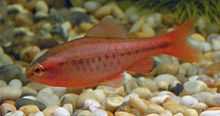Cherry barb
| Cherry barb | |
|---|---|
 | |
| male | |
| Conservation status | |
| Scientific classification | |
| Kingdom: | Animalia |
| Phylum: | Chordata |
| Class: | Actinopterygii |
| Order: | Cypriniformes |
| Family: | Cyprinidae |
| Genus: | Puntius |
| Species: | P. titteya |
| Binomial name | |
| Puntius titteya Deraniyagala, 1929 | |
| Synonyms | |
|
Barbus titteya (Deraniyagala, 1929) | |
The cherry barb (Puntius titteya) is a tropical fish belonging to the spotted barb genus of the Cyprinidae family. It is native to Sri Lanka, and introduced populations have become established in Mexico and Colombia. The cherry barb was named Puntius titteya by Paules Edward Pieris Deraniyagala in 1929. Synonyms include Barbus titteya and Capoeta titteya.
The species is commercially important in the aquarium trade, and it is in danger of being overfished for this industry. It was listed as a least-concern species in 1996.[1]
Description
The cherry barb is an elongated fish with a relatively compressed body. It reaches 5 cm in length. It is fawn-colored on top with a slight greenish sheen. Its sides and belly have gleaming silver highlights. A horizontal stripe extends from the tip of the snout through the eye to the base of the caudal fin. It is brown- or blue-black with a metallic edge, turning to blue or sea green toward the tail. The male is more red than the female, becoming deep red when breeding. The dominant male often has the brightest red color. The female is lighter, with yellowish fins.
Habitat
The cherry barb's natural habitat is a heavily shaded, shallow, and calm water body. Its native substrate is silty with leaf cover. It comes from a tropical climate and prefers water with a pH of 6 to 8, a water hardness (dH) of 5 to 19, and a temperature range of 73°F to 81°F (23°C to 27°C).[2]
In the aquarium
The fish is most often kept in community tanks by aquarium hobbyists. The cherry barb is a schooling fish and is best kept in groups of five or more individuals, though the schools are often less discrete than those of other barbs. There should be a ratio of at least two females to one male. The male will constantly harass the females to breed, and if there are multiple females, each can escape the attentions of the male for a time. The average lifespan is four years, with a maximum around seven years. The tank should have abundant plant material (about two-thirds to three-quarters of the tank), but the fish also needs open space to swim. It tends to hide and will often withdraw under the cover of plants. The younger male is generally peaceful, but a mature male can be aggressive when breeding. Appropriate tankmates include Rasbora and similar calm fish.
Breeding
When breeding, the males swims just behind the female, chasing away rival males. The female will spawn 200 to 300 eggs and scatter them on plants and on the substrate. It may eat its own eggs. The eggs hatch in one to two days and the fry are free-swimming after two more days. After five weeks, the hatchlings will be about 1 cm long and easily identifiable as cherry barbs.
References
- ↑ Pethiyagoda, R. 1996. Puntius titteya. In: IUCN 2012. IUCN Red List of Threatened Species. Version 2012.2. Downloaded on 29 May 2013.
- ↑ Froese, R. and D. Pauly, Eds. Puntius titteya. FishBase. 2011.
